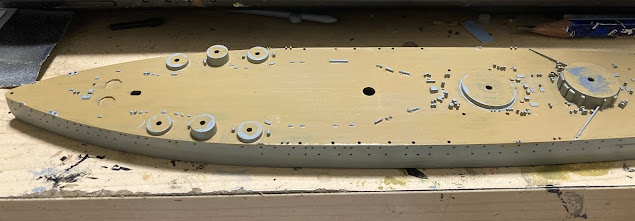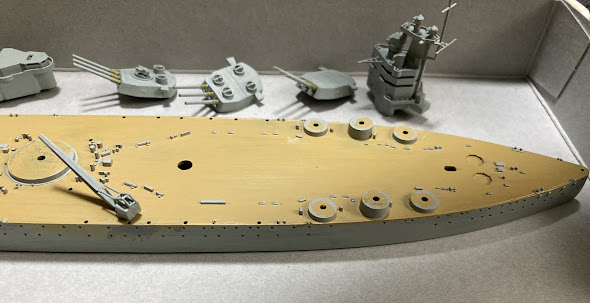Tamiya 1.700 HMS Nelson. A battleship that broke the mold.
HMS Nelson Royal Navy Battleship of World War Two. A smart image on the front.
26 May 1927 - Spectators on the Cornwall coast saw a weird ship doing her steaming trials over the Royal Navy's test course; unlike any ship they had ever seen before, clearly a warship, but all her superstructure was crowded aft, and only three large humps (for gun turrets to sit on) distinguished her very long forecastle. An odd-looking battleship indeed.
Checking out the box.
Other models on the side. Obviously I want to do the Rodney too.
The Nelson-class battleship was essentially a smaller, 23-knot (43 km/h; 26 mph) battleship version of the G3 battlecruiser which had been cancelled for exceeding the constraints of the 1922 Washington Naval Treaty. The design, which had been approved six months after the treaty was signed, had a main armament of 16-inch (406 mm) guns to match the firepower of the American Colorado and Japanese Nagato classes in the battleline in a ship displacing no more than 35,000 long tons (36,000 t).
You always get good value from the older Tamiya kits.
She was commissioned at Portsmouth on 15 Aug 1927, and Portsmouth remained her home port throughout her life. During gunnery tests, the new 16-inch guns had numerous teething troubles, and caused more blast damage than had been expected. Barrel life fell short of the proven 15-inch gun's endurance.
Slipping through the Panama canal.
Nonetheless, in October 1927, the "Nellie" became the flagship of the Home Fleet, which she remained until 1941. Before the war she mostly served in home waters, but went to Gibraltar and the Mediterranean for annual naval exercises. She also ventured as far as the Baltic and the Pacific, on making her first transit of the Panama Canal. In 1932-33, she underwent modifications to her bridge, had two MK.V eight-barreled anti-aircraft guns added, and had multiple machine-guns fitted on the control tower.
Painting the deck first.
Picking out the detail in grey.
The main battery of the Nelson-class ships consisted of nine breech-loading 16-inch guns in three turrets forward of the superstructure.


Nelson had a length between perpendiculars of 660 feet (201.2 m) and an overall length of 709 feet 10 inches (216.4 m), a beam of 106 feet (32.3 m), and a draught of 30 feet 4 inches (9.2 m) at mean standard load. She displaced 33,300 long tons (33,800 t) at standard load and 37,780 long tons (38,390 t) at deep load.
The ship was powered by two sets of Brown-Curtis geared steam turbines, each driving one shaft, using steam from eight Admiralty 3-drum boilers. The turbines were rated at 45,000 shaft horsepower (34,000 kW) and intended to give the ship a maximum speed of 23 knots. During her sea trials on 26 May 1927, Nelson reached a top speed of 23.6 knots (43.7 km/h; 27.2 mph) from 46,031 shp (34,325 kW). The ship carried enough fuel oil to give her a range of 7,000 nautical miles (13,000 km; 8,100 mi) at a cruising speed of 16 knots (30 km/h; 18 mph).
More Pre-war Improvements.
Between 1935 and 1938, the Royal Navy continued modernizing Nelson. She participated in testing the experimental "Walrus" amphibian aircraft; she had horizontal armour was added; high angle gun-control was improved, and a crane was fitted in the port waist. As the Navy recognized the growing threat of airpower, even more anti-aircraft "pom-pom" guns were added near the funnel and on the quarterdeck.
Armourment for the Nelson.
The main battery of the Nelson-class ships consisted of nine breech-loading 16-inch guns in three turrets forward of the superstructure.
Preparing the guns...
Adding the guns...

Weathering the deck. Picking out the details as we go...

Their secondary armament consisted of a dozen 6-inch (152 mm) Mk XXII guns in twin-gun turrets aft of the superstructure, three turrets on each broadside.
Their anti-aircraft (AA) armament consisted of six quick-firing (QF) 4.7-inch (120 mm) Mk VIII guns in unshielded single mounts and eight QF 2-pounder (40-millimetre (1.6 in)) guns in single mounts.
The ships were fitted with two submerged 24.5-inch (622 mm) torpedo tubes, one on each broadside, angled 10° off the centreline.
Comlpeting the superstructure...


That's about it now. Most of the model is finished. Details now.
Adding the upper main mast and rigging.
Protection
The ships' waterline belt consisted of Krupp cemented armour (KC) that was 14 inches (356 mm) thick between the main gun barbettes and thinned to 13 inches (330 mm) over the engine and boiler rooms as well as the six-inch magazines, but did not reach either the bow or the stern.
To improve its ability to deflect plunging fire, its upper edge was inclined 18° outward.[6] The ends of the armoured citadel were closed off by transverse bulkheads of non-cemented armour 8 and 12 inches (203 and 305 mm) thick at the forward end and 4 and 10 inches (102 and 254 mm) thick at the aft end.
I'm very happy with the result.
Finishing the rigging.
Making a base.
Aluminium and PVA to create the wavelets and additional PVA for the wave caps...
...and we are done.
A protective case to keep the final mnodel from damage. It's not ideal but actually a draw for the fridge but it does the job fine


























































Comments
Post a Comment